Designing With Conifers: How to Pull Together Your Landscape
http://decor-ideas.org 04/21/2015 23:13 Decor Ideas
Conifers are a diverse group of plants, much more complex and interesting than the Christmas trees that immediately spring to mind. Such diversity is admired by some gardeners, causes obsession in others and intimidates more than a few. We’ve already looked at myriad shapes, sizes, colors and textures as well as companion plants in previous articles. But how do we assemble these plants in a cohesive garden design that is just right — not too boring and not too busy?
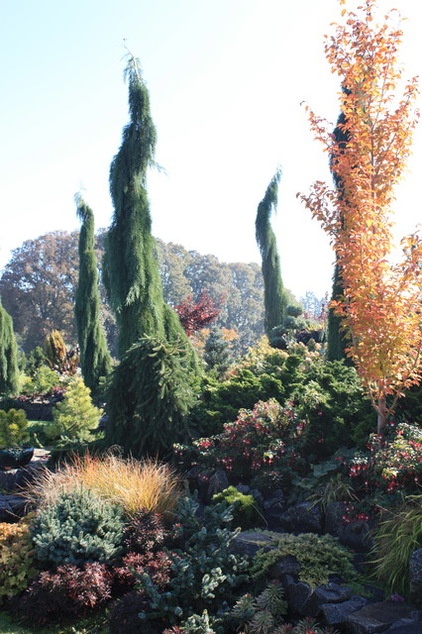
Conifer gardens done well are spaces that are full of interest, intrigue and artistry. Strong and dominant types, like these pendulous sequoias (Sequoiadendron giganteum ‘Pendulum’, find your zone), need proper placement and a supporting cast of bedmates that can hold their own with style.
In the garden shown here, the sequoias are placed in a way that creates a rhythm that pulls the eye through the space, while a strong underplanting scheme grounds the space by creating multidimensional interest. Points of interest are everywhere, from the broad scheme to small vignettes. How is something like this done, you ask?
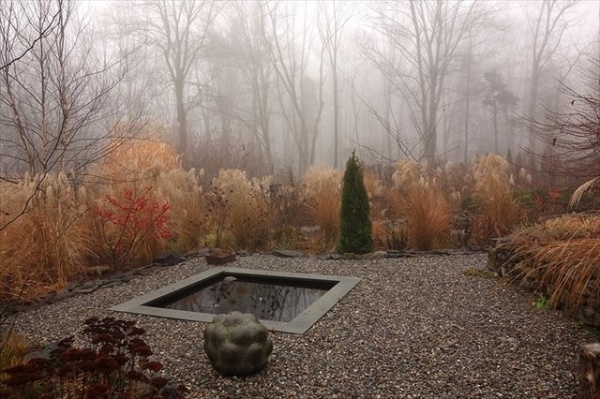
First, create a mood. The best gardens are those that are moody, those that elicit feelings in the minds of those who visit. Your personality will most likely be a starting point for determining a mood, as most gardens are reflections of their creators. If you have a large space, you can create different gardens around different moods.
The garden shown here is undeniably somber, reflective and philosophical. The lone conifer speaks volumes, as it stands in stark contrast to its garden mates. Sometimes less is more when creating this type of moody garden.
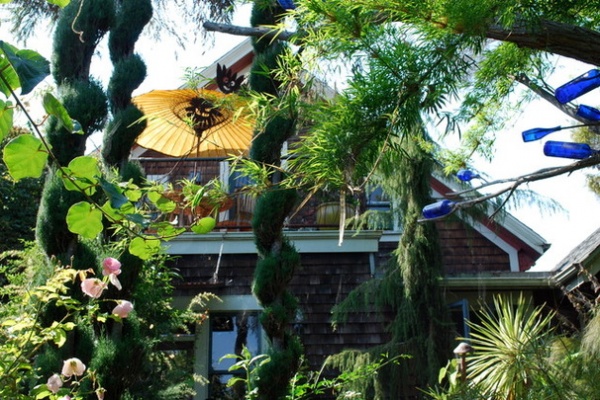
This garden by Berkeley, California, artist Marcia Donahue screams whimsy and stands in stark contrast to the previous space. Here, an installation of spiral-pruned conifers is exuberant with a sense of humor.
Find your garden personality
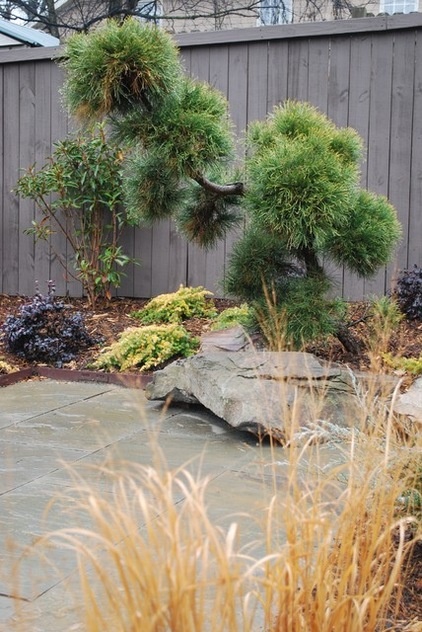
Establish a focal point. A good garden helps its visitors by showing them where to look. A small garden may have one focal point, while a large space may have several. Conifers, such as this pruned Austrian pine (Pinus nigra, zones 4 to 7), can be very sculptural and can establish focal points all by themselves. This pine commands attention by hanging over a small urban patio and is contrasted by an underplanting of low Golden Pacific shore junipers (Juniperus conferta ‘sPg-3-016’, zones 6 to 9).
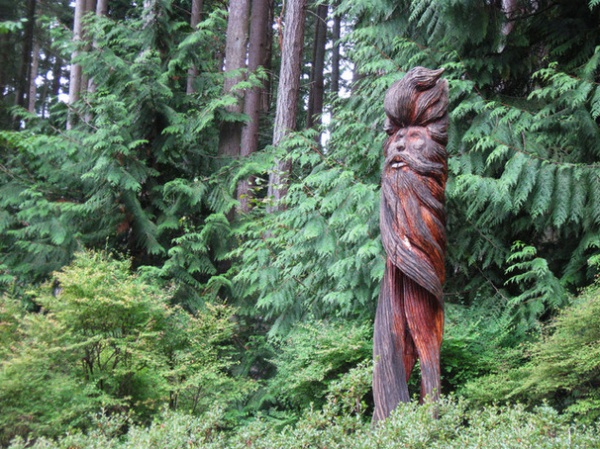
If you are a gardener with an affinity for garden sculpture, thoughtfully chosen conifers can complete the vignette. Study your art piece for clues as to which conifers to choose for close placement. These Alaska cedars (Chamaecyparis nootkatensis, zones 4 to 7) make the perfect bedmates for this sculpture, completing the vignette rather than competing or being a boring backdrop. The texture and weeping nature of the foliage mimic the texture and lines of the sculpture, forming an appropriate relationship.
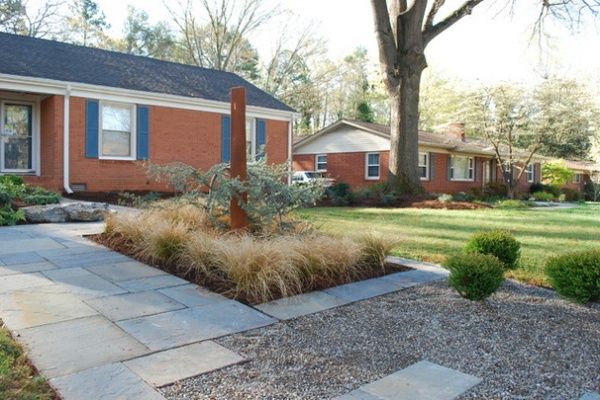
In this garden the Blue Cascade atlas cedar (Cedrus atlantica ‘Blue Cascade’, zones 7 to 9) is an integral part of the twist steel sculpture by John Dupree, wrapping around it. An underplanting of prairie fire sedge (Carex testacea ‘Indian Summer’, zones 6 to 9) complements the texture of the cedar while pulling the orange hue of the art down to ground level. A trio of Mr. Bowling Ball arborvitaes (Thuja occidentalis ‘Bobozam’, zones 3 to 8) adds a contrasting shape, color and texture to this strong vignette.
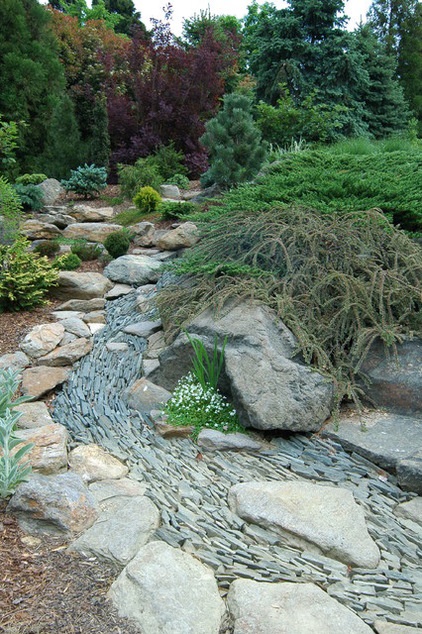
Use conifers to soften hardscape. A successful conifer garden is full of juxtaposition. There are times when a strong sculptural or hardscape element needs softening for it to make a connection with the rest of the garden.
The sculptural dry creek bed shown here is a strong focal point. Notice how the pine, spruce, arborvitae, juniper and cotoneaster plantings create a relationship between the piece and the larger garden. This conifer selection, rich in shapes, holds its own against such a strong focal point while creating the transition.
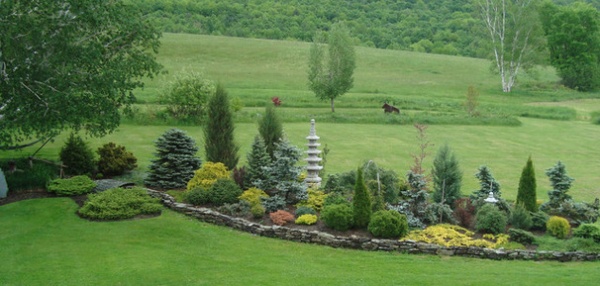
Choose you conifer palette. Now that you have decided on the mood and focal points your garden should have, we can go shopping. Good garden centers offer an appetizing buffet of conifers in spring and fall. Be forewarned that such a variety frequently elicits emotional rather than thoughtful buying.
Keep in mind the scale of your space. There are exceptions, but generally a smaller space requires small to medium-size conifer selections, both from practical and aesthetic standpoints. Feel free, however, to mix up shapes, foliage colors and textures, as this is what creates a multidimensional and personal garden. It is important to find a common thread between close garden bedmates based on these criteria. Perhaps you like a very diverse plant palette. Find a transitional plant that exhibits characteristics of its bedmate on either side, or underplant the entire space with one ground cover to knit your garden together.
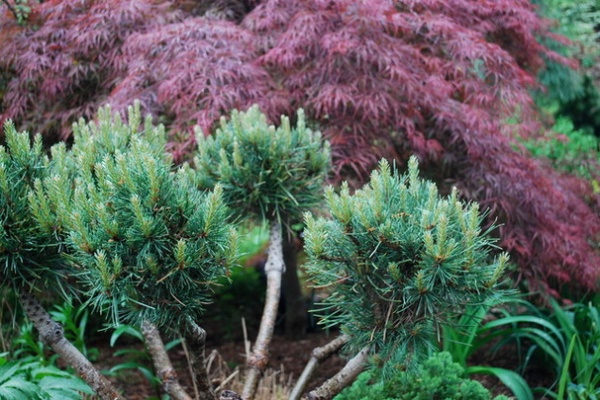
Add supporting actors. A wide range of shrubs, trees and perennials to complement your conifer collection is available. A quick study of the color wheel will help you choose wisely. Pick complementary colors for strong interest or choose colors with similar undertones to tie your space together.
In the garden here, a pruned Scots pine (Pinus sylvestris, zones 3 to 7) makes an appropriate connection with a Crimson Queen Japanese maple (Acer palmatum var. dissectum ‘Crimson Queen’, zones 5 to 8), because the green of the pine and the red of the maple both exhibit undertones of blue. It’s this subtle attention to detail that will set your garden apart from those of your neighbors.
Other suitable companion plants include ornamental grasses, flowering shrubs and many perennials. Be advised not to plant tall perennials or grasses in very close proximity to dense conifers, as the shade they produce can cause dieback on sections of your conifer.
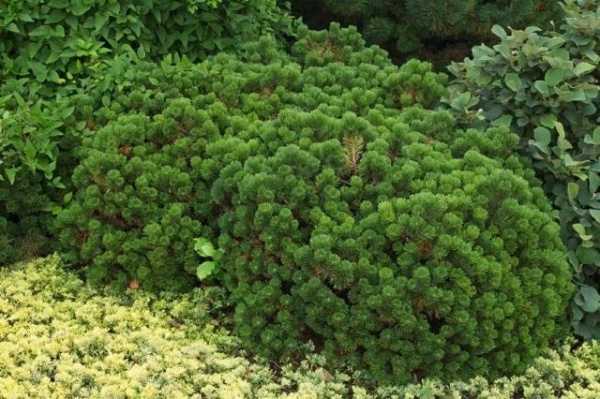
Don’t forget to layer. Unless you are using a conifer as a focal point, lower plants should generally be placed in the front of the bed, with taller plants progressing toward the rear. Fortunately, there is a wide variety of low-growing conifers available for placement up close and personal. Certain pines, such as this mugo (Pinus mugo cvs, zones 2 to 8), as well as certain junipers, arborvitaes and prostrate hemlocks and cedars make great front-of-the-bed candidates.
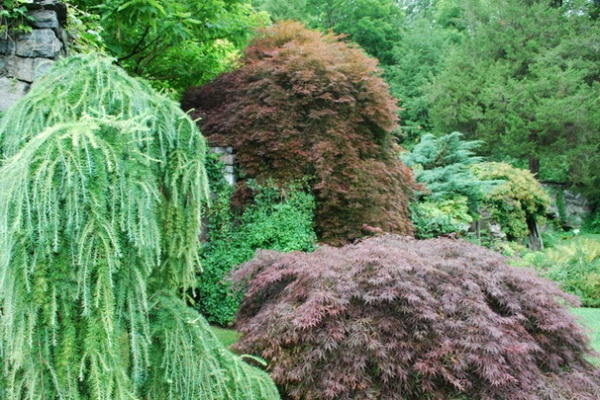
Garden Case Study: Innisfree Garden
Innisfree Garden, in Millbrook, New York, is probably the best garden I’ve had the privilege to visit. This estate-turned-public-garden is exceptional in its use and display of boulders, conifers and specimen plants.
Notice the ironic yet pleasing simplicity and complexity of this garden vignette. A weeping larch (Larix decidua ‘Pendula’, zones 3 to 6) leads us off, followed by two Japanese maples, then a juniper. A bed of ostrich ferns (Matteuccia struthiopteris, zones 3 to 7) finishes the scene. The mounding shape of the larch mimics, but does not match, the form of the maples. The color similarity of the maples is close enough to be soothing, yet is not matchy. The Grey Owl juniper (Juniperus virginiana ‘Grey Owl’, zones 4 to 9) adds to the vignette by lending texture, form and color. The ostrich ferns mimic the texture of the larch while contrasting its form.
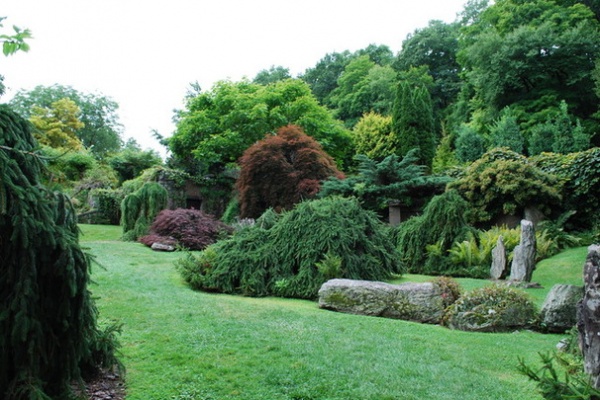
This broader view shows how the intense interest of the conifer collection pulls the eye through the space. Where the eye goes, the body follows. Notice how the rounded, mounding and weeping forms of the trees create a connection with one another, while a variety of color creates excitement. This vignette wouldn’t be nearly as exciting if all the plants were dark green.
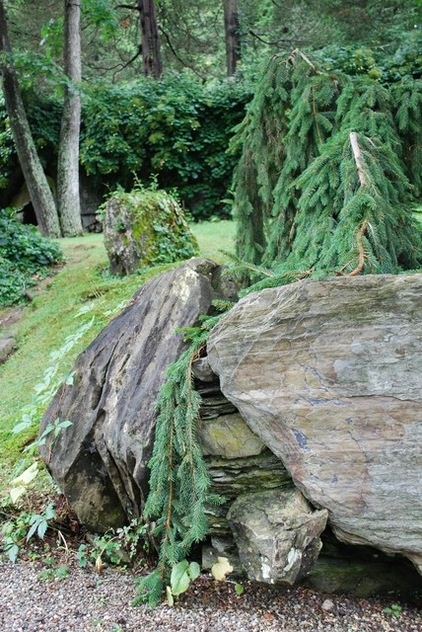
Focal points abound at Innisfree. Funds were severely cut at the time the garden was being transformed from private to public, so landscape architect Lester Collins employed and repurposed existing boulders, creating sculptural focal points. Notice how this weeping Norway spruce (Picea abies ‘Pendula’, zones 2 to 8) makes a strong and contrasting connection with this installation of boulders. Scenes such as this abound at Innisfree.
Using these principles can elevate your garden from mundane to exceptional. Be sure to show us how and where you end up.
More:
Finding the right garden bedmates for your conifer garden
More Houzz guides to foliage
Related Articles Recommended












